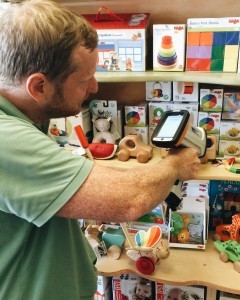How do you know that the toys and other products you buy for your kids are safe? You probably don't since good information is hard to come by, but Joshua Kasteler and Safe Ducky can help you find out with one simple test.
Kasteler, 40, spent several years in Asia as a chemical engineer. Part of his job was to test products on the assembly lines for toxicity, often weeding out those that had high levels of toxins such as lead, mercury and phthalates, among others. But he quickly learned that harmful chemicals can often slip through the manufacturing and distribution process and end up in the consumer products we buy in the U.S.
So Kasteler decided he could do something about it. He recently moved from Boston to Los Angeles, and he's started a company called Safe Ducky. Its sole mission is to find out what children's products on the shelves now are safe and which ones are not.
"We don't know much about the chemicals that we expose ourselves and our children to every day," say Kasteler (left, testing for toxins). "We bring home toys and clothing without knowing how they were made, and the fact is, some of those items may have toxic chemicals in them."
Kasteler says the biggest risk factors for toxic products come from three areas: offshore manufacturing, lack of oversight in the manufacturing process itself and limited testing.
"Most products today are not made by the company listed on the label," he says, "but by offshore contract manufacturers. While many of these factories are responsible businesses, the lack of supervision in some of these remote factories can allow for gaps in safety."
Kasteler created Safe Ducky to test children's products right in the store, the first time the consumer comes in direct contact with them. The Safe Ducky process takes a product off the shelf and runs a test with sophisticated portable scanners that allow Kasteler to see the chemical content. In a matter of seconds a read out will tell him--and the store owner--whether or not that product is safe.
Products with toxins over the legal limit are immediately removed from the shelves. Then the store owner and the Safe Ducky team go back to the manufacturer to work out a solution to the problem. When all toxic products have been removed, the store is placed on the Safe Ducky website (www.safeducky.com) , which indicates it is safe for parents to shop there.
This ground level testing is in sharp contrast to the testing that goes on--or doesn't--at the national level.
The Consumer Product Safety Commission (CPSC) is charged by the federal government with testing all imports for harmful chemicals. But the CPSC is woefully underfunded and undermanned. There are only about 500 employees for the entire country, and the budget is only $155 million a year. By contrast, the Food and Drug Administration (FDA) has a $3.2 billion budget and employs 40,000 people.
In 2013 the CPSC examined only 0.07 per cent of products imported to the United States, with half of those inspections made for toys. As far back as 2006 Michael P. Wilson, then a Professor of the School of Public Health at UC Berkeley, warned the U.S. Congress that the U.S. may fall behind the rest of the world without stronger consumer protection against toxic chemicals.
It is possible that pending legislation in Congress will tighten up the testing oversight this fall as the Congress debates the first update to the Toxic Substances Control Act in 40 years. Both industry and consumer groups are working hard to press their point of view
Kasteler is on the right track by taking the process to the local level, where he provides information for both families and retailers about product safety for the products they buy right next door. But he may also be in the vanguard of a new movement to empower consumers everywhere to be more aware of chemical hazards in other things they buy every day.
"This reminds me of that famous clip on YouTube about the guy dancing alone at a rock concert," he says. "Sure, it takes courage to dance by yourself, but it's the first supporter who decides to join the dance that transforms him from that 'crazy dancing guy' to a 'movement'."
Kasteler and Safe Ducky clearly intend to become part of that movement.
